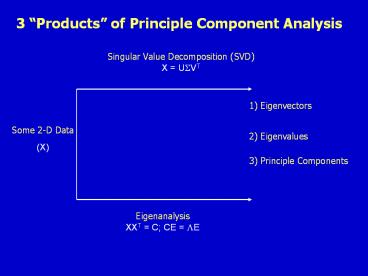Regression Maps vs. Correlation Maps - PowerPoint PPT Presentation
Title:
Regression Maps vs. Correlation Maps
Description:
Title: Regression Maps vs. Correlation Maps Author: jcasola Last modified by: jcasola Created Date: 11/20/2006 11:47:12 PM Document presentation format – PowerPoint PPT presentation
Number of Views:330
Avg rating:3.0/5.0
Title: Regression Maps vs. Correlation Maps
1
3 Products of Principle Component Analysis
Singular Value Decomposition (SVD)X USVT
1) Eigenvectors
Some 2-D Data (X)
2) Eigenvalues
3) Principle Components
Eigenanalysis XXT C CE LE
2
Examples for Today
1) Eigenvectors Variations explained in the
horizontal
Photo (X)
2) Eigenvalues - of Variance explained
3) Principle Components Variations explained in
the vertical
1) Eigenvectors Variations explained in space
(MAPS)
Fake and Real Space-Time Data (X)
2) Eigenvalues - of Variance explained
(spectrum)
3) Principle Components Variations explained in
the time (TIMESERIES)
3
Examples for Today
1) Eigenvectors Variations explained in space
(MAPS)
Fake and Real Space-Time Data (X)
2) Eigenvalues - of Variance explained
(spectrum)
3) Principle Components Variations explained in
the time (TIMESERIES)
4
Eigenvectors, Eigenvalues, PCs
- Eigenvectors explain variance in one dimension
Principle components explain variance in the
other dimension. - Each eigenvector has a corresponding principle
component. The PAIR define a mode that explains
variance. - Each eigenvector/PC pair has an associated
eigenvalue which relates to how much of the total
variance is explained by that mode.
5
EOFs and PCs for geophysical data
- For geophys. data, we often set it up so that the
eigenvectors give us spatial structures (EOFs
empirical orthogonal functions) and the PCs give
us an associated time series (principle
components) . - The EOFs and PCs are constructed to efficiently
explain the maximum amount of variance in the
data set. - In general, the majority of the variance in a
data set can be explained with just a few EOFs.
6
EOFs and PCs for geophysical data
- By construction, the EOFs are orthogonal to each
other, as are the PCs. - Provide an objective method for finding
structure in a data set, but interpretation
requires physical facts or intuition.
7
Variance of Northern Hemisphere Sea Level
Pressure Field in Winter
8
PCA for the REAL Sea-Level Pressure Field
EOF 1 AO/NAM (23 expl).
EOF 2 PNA (13 expl.)
EOF 3 non-distinct(10 expl.)
9
EOF 1 (AO/NAM) EOF 2 (PNA)
EOF 3 (?)
PC 1 (AO/NAM) PC 2 (PNA)
PC 3 (?)
10
PCA An example using contrived data
11
(No Transcript)
12
EOF 1 - 60 variance expl.
EOF 2 - 40 variance expl.
PC 1
PC 2
13
Eigenvalue Spectrum
EOF 1 - 60 variance expl.
EOF 2 - 40 variance expl.
PC 1
PC 2
14
PCA Example 2 based on contrived data
15
EOF 1 - 65 variance expl.
EOF 2 - 35 variance expl.
PC 1
PC 2
16
Significance
- Each EOF / PC pair comes with an associated
eigenvalue - The normalized eigenvalues (each eigenvalue
divided by the sum of all of the eigenvalues)
tells you the percent of variance explained by
that EOF / PC pair. - Eigenvalues need to be well separated from each
other to be considered distinct modes.
First 25 Eigenvalues for DJF SLP
17
Significance The North Test
First 25 Eigenvalues for DJF SLP
- North et al (1982) provide estimate of error in
estimating eigenvalues - Requires estimating DOF of the data set.
- If eigenvalues overlap, those EOFs cannot be
considered distinct. Any linear combination of
overlapping EOFs is an equally viable structure.
18
Validity of PCA modes Questions to ask
- Is the variance explained more than expected for
null hypothesis (red noise, white noise, etc.)? - Do we have an a priori reason for expecting this
structure? Does it fit with a physical theory? - Are the EOFs sensitive to choice of spatial
domain? - Are the EOFs sensitive to choice of sample? If
data set is subdivided (in time), do you still
get the same EOFs?
19
Regression Maps vs. Correlation Maps
PNA - Correlation map (r values of each point
with index)
PNA - Regression map (meters/std deviation of
index)
20
(No Transcript)
21
Practical Considerations
- EOFs are easy to calculate, difficult to
interpret. There are no hard and fast rules,
physical intuition is a must. - Due to the constraint of orthogonality, EOFs tend
to create wave-like structures, even in data sets
of pure noise. So pretty so suggestive so
meaningless. Beware of this.
22
Practical Considerations
- EOFs are created using linear methods, so they
only capture linear relationships. - By nature, EOFs give are fixed spatial patterns
which only vary in strength and in sign. E.g.,
the positive phase of an EOF looks exactly like
the negative phase, just with its sign changed.
Many phenomena in the climate system dont
exhibit this kind of symmetry, so EOFs cant
resolve them properly.
23
(No Transcript)
24
(No Transcript)
25
(No Transcript)

